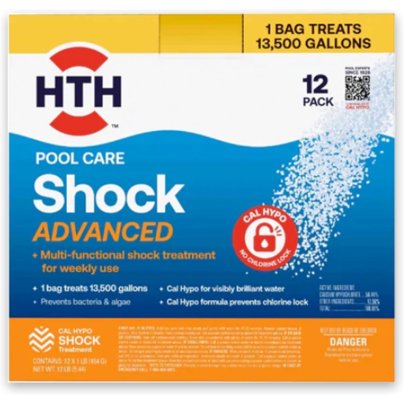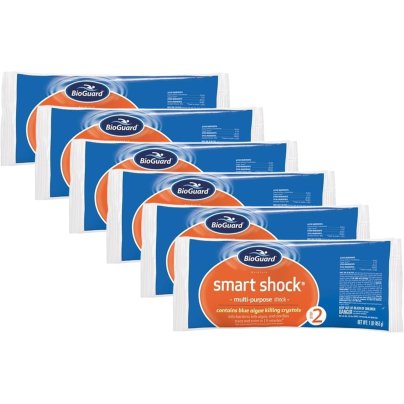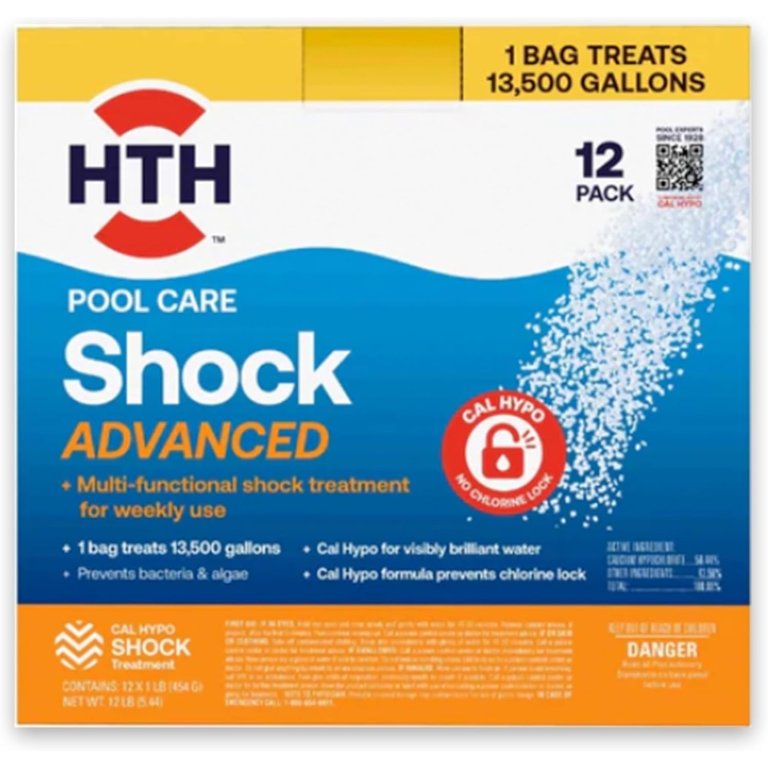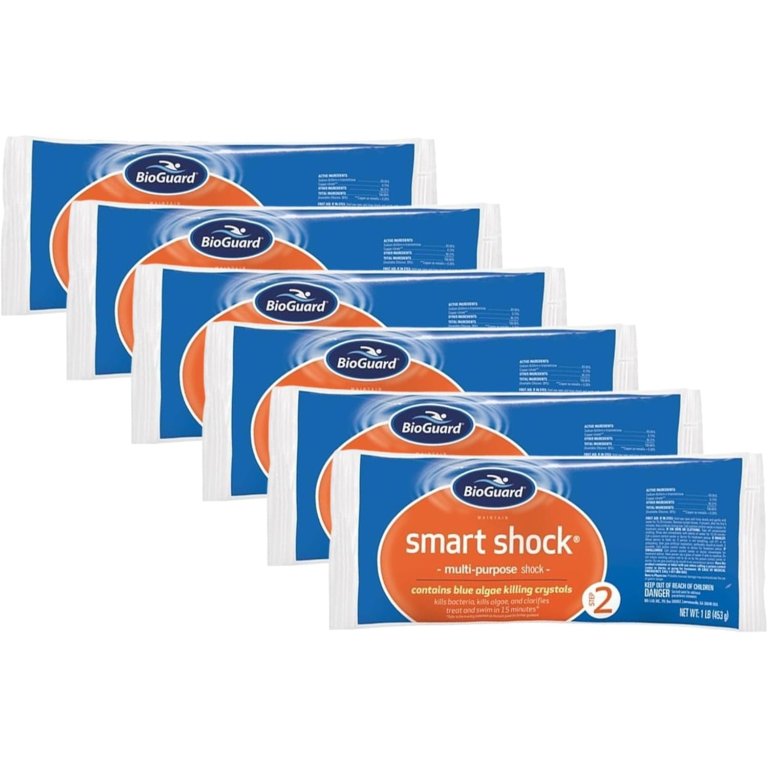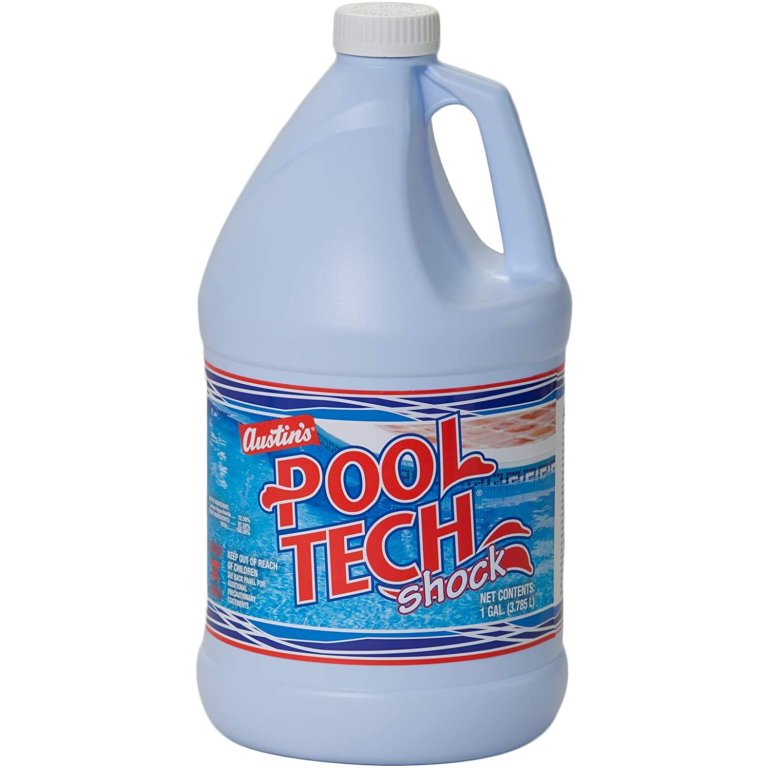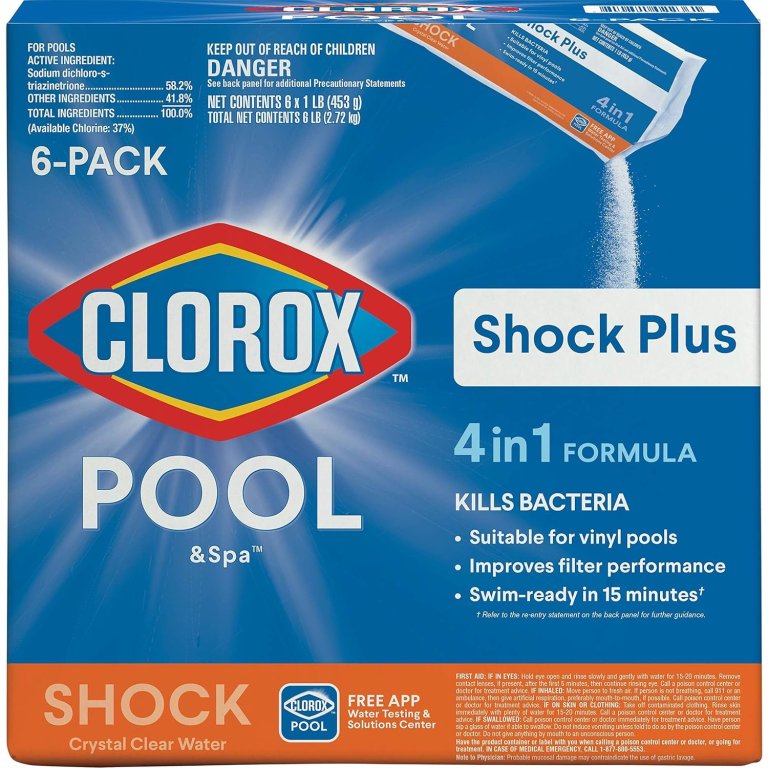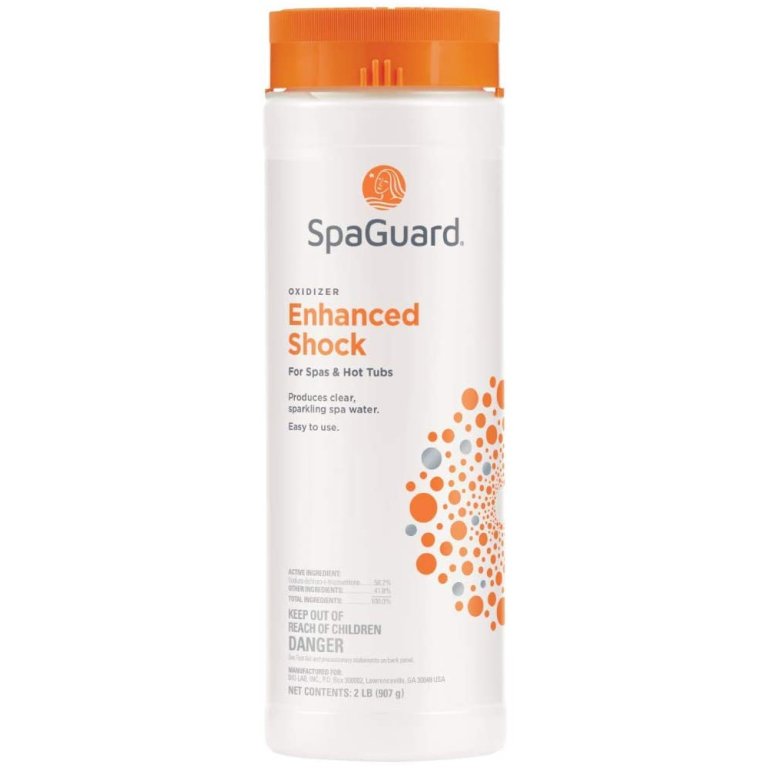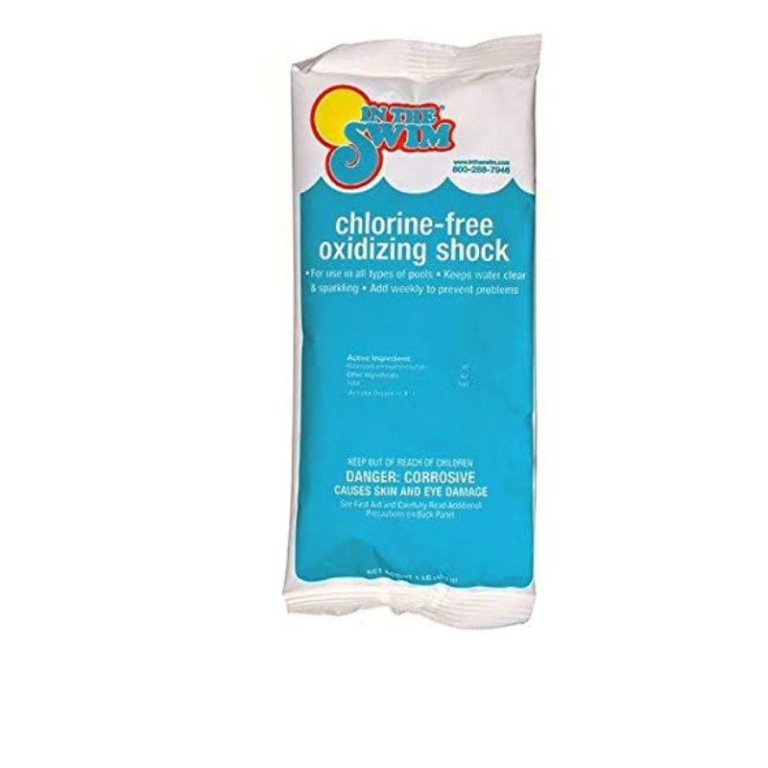
We may earn revenue from the products available on this page and participate in affiliate programs. Learn More ›
When it’s time to open your swimming pool for the season, or when the water starts looking cloudy or algae-prone, a pool shock treatment is your first line of defense. Pool shock increases the chlorine levels in the water to kill bacteria, eliminate contaminants, and restore water clarity. It’s a must-have for pool owners looking to maintain a clean and safe swimming environment.
With so many types of shock on the market—from calcium hypochlorite to dichlor and non-chlorine options—choosing the right one can make a big difference in effectiveness, ease of use, and long-term water balance. To help narrow it down, we tested four popular pool shock products, evaluating each for performance, ease of application, and overall value. We also considered multiple untested but highly rated options that consistently receive strong reviews.
Our top recommendation is HTH Pool Care Shock Advanced, thanks to its multifunctional formula that not only sanitizes but also clarifies water and reduces chlorine odor. It’s a standout pick for pool owners who want reliable results at a reasonable price—especially in the 12-pack size. Keep reading to learn more about the best pool shocks, plus helpful tips for how and when to use each type.
- BEST OVERALL: HTH Pool Care Shock Advanced
↓ Jump to Review - BEST BANG FOR THE BUCK: DryTec Calcium Hypochlorite Chlorinating Shock
↓ Jump to Review - BEST POWDER: BioGuard Smart Shock
↓ Jump to Review - BEST LIQUID: Austin’s Pool Tech Shock
↓ Jump to Review - BEST FOR VINYL POOLS: Clorox Pool & Spa Shock Plus
↓ Jump to Review - BEST SPA AND HOT TUB: SpaGuard Enhanced Shock
↓ Jump to Review - BEST SALTWATER POOL: In The Swim Chlorine-Free Oxidizing Pool Shock
↓ Jump to Review

Before You Buy a Pool Shock
Most pool shock products rapidly increase the chlorine level in the water, altering the pH enough to kill any invisible bad guys. The filtration system then pulls the bugs and plant life out of the water, ensuring that it’s clean for swimming. Instead of chlorine, some pool shock treatments use potassium monopersulfate, a more effective solution for saltwater pools.
Before you buy a shock treatment for your pool, it’s important to decide whether your preferred form is liquid or powder, and you should also take into account the current pH level of the water. Avoid using a swimming pool with a pH level lower than 7, as this acidic solution can cause itching, burning, and rashes. Water with a pH balance above 7.8 is also problematic since it can lead to cloudy water and scale buildup.
Pool Shocks Comparison
| Product | Form | Type | Chlorine level |
| HTH Pool Care Shock Advanced | Powder | Calcium hypochlorite | 56.44% |
| DryTec Calcium Hypochlorite Chlorinating Shock | Powder | Calcium hypochlorite | 68% |
| BioGuard Smart Shock | Powder | Sodium dichloro-s-triazinetrione | 63.05% |
| Austin’s Pool Tech Shock | Liquid | Sodium hypochlorite | 12.5% |
| Clorox Pool & Spa Shock Plus | Powder | Sodium dichloro-s-triazinetrione | 58.2% |
| SpaGuard Enhanced Shock | Powder | Sodium dichloro-s-triazinetrione | 58.2% |
| In The Swim Chlorine-Free Oxidizing Pool Shock | Powder | Potassium monopersulfate | Zero (Chlorine-free) |
Our Top Picks
The list of top products below was selected based on the shopping tips and considerations mentioned above, with significant emphasis on product efficacy and overall value. These products are among the best shocks for swimming pools.
Best Overall
Photo: AmazonWhat We Like
- Clears water fast, often within 48 hours
- Easy to use, even for beginners
- Budget-friendly bulk pack
- Great for regular maintenance
What We Don’t Like
- Inconsistent algae control
- Chlorine boost may be weak
Product Specs
- Form Powder
- Type Calcium hypochlorite
- Chlorine Level 56.44%
Our Ratings
| Ease of Use | 5/5 | Effectiveness | 4.5/5 | Value | 5/5 |
We’ve used the HTH Pool Care Shock Advanced several times now, and it’s become a reliable part of our pool maintenance routine—especially at the start of swim season. It’s incredibly easy to use: Just pour it in, let the filter run, and within a day or two, the water is noticeably clearer. It’s especially convenient for quick cleanups after a storm or heavy pool use. One thing we appreciate is that it comes in a bulk 12-pack, which makes it more affordable in the long term and ensures we always have some on hand.
That said, while this calcium hypochlorite shock usually does a great job keeping the water clean and clear, it hasn’t been 100% consistent when it comes to algae control (our pool in Florida seems to struggle most with this issue). Some applications seem to knock algae out fast, while other times we’ve had to follow up with a dedicated algaecide. We’ve also noticed it doesn’t always provide a strong chlorine boost, which might be a concern depending on your pool’s size or condition. Still, for general upkeep and especially for folks in hot, sunny climates like Florida, this shock performs well overall.
What our tester says: “The HTH shock was easy to use and cleared up my pool water fast—by the next day, it looked crystal clear and swim-ready”—Paul Rankin, Product Reviews tester and writer.
Get the HTH pool shock at Amazon, Lowe’s, Ace Hardware, The Home Depot, or Walmart.
Best Bang For The Buck
Photo: AmazonWhat We Like
- Premeasured pouches for easy use
- Great value for a season’s worth
- Clears water quickly
- Dissolves in 30 minutes
What We Don’t Like
- Chlorine boost can be mild
- May need backup for tough jobs
Product Specs
- Form Power
- Type Calcium hypochlorite
- Chlorine level 68%
Our Ratings
| Ease of Use | 5/5 | Effectiveness | 4/5 | Value | 5/5 |
We tested the DryTec Calcium Hypochlorite Pool Shock over 2 weeks, using it twice to gauge how well it worked as part of our pool’s regular maintenance. What immediately stood out is how convenient it is—each pouch contains exactly 1 pound of shock, premeasured to treat up to 10,000 gallons. No scooping, no guessing. Just tear it open and pour it in. The 24-pack is a budget-friendly bulk option, making it easy to stock up for the entire season without overspending.
This shock dissolves quickly—within about 30 minutes—and both times we used it, the water looked noticeably clearer the next day. It contains 68 percent calcium hypochlorite, which delivers a chlorine concentration of up to 65 percent. It handled everyday sanitizing tasks well and kept the water looking fresh. That said, the chlorine boost wasn’t always as strong as we’d hoped, so if you’re dealing with algae or a big pool party aftermath, you might need to supplement with tabs or algaecide. Still, for weekly upkeep, it’s a dependable and cost-effective option.
What our tester says: “I liked that the DryTec packets were premeasured and easy to toss in—after each use, my pool looked cleaner by the next morning without much effort”—Paul Rankin, Product Reviews tester and writer.
Get the DryTec pool shock at Amazon, The Home Depot, or Walmart.
Best Powder
Photo: AmazonWhat We Like
- Dissolves quickly and easily
- Clears algae without liner damage
- Keeps water sparkling clean
- No strong chlorine odor
What We Don’t Like
- Higher price per treatment
- Smaller quantity per pack
Product Specs
- Form Powder
- Type Sodium dichloro-s-triazinetrione
- Chlorine level 63.05%
Our Ratings
| Ease of Use | 5/5 | Effectiveness | 4.5/5 | Value | 3.8/5 |
We tested the BioGuard Smart Shock by using two 1-pound bags over a 2-week period, and we were genuinely impressed with the results. Each dose dissolved quickly and left our pool looking crystal clear within a day. It’s one of the easiest shock treatments we’ve used—just open a premeasured pouch, pour it in, and let it work. The product claims to clear up algae and sanitize without bleaching liners, and based on our experience, that holds up. We didn’t notice any damage or residue, just clean, inviting water.
This pool shock powder worked well for both regular upkeep and as a post-rain treatment. It’s marketed as a multifunctional shock with a built-in clarifier and buffer, and we can see why people are willing to pay a little more for it. That said, the 6-pack isn’t the most budget-friendly option out there. If you’ve got a large pool or need to shock frequently, the cost can add up. Still, the performance was reliable and the results were consistently great, which might be worth the premium for some users.
Get the BioGuard pool shock at Amazon, Walmart, PoolGeek, or HydroPool.
Best Liquid
Photo: AmazonWhat We Like
- Ready-to-use liquid—no mixing required
- Fast results with no residue
- Doesn’t alter cyanuric acid levels
What We Don’t Like
- Less cost-effective for frequent use
- Bulky jug can be harder to store
Product Specs
- Form Powder
- Type Sodium hypochlorite
- Chlorine level 12.5%
Our Ratings
| Ease of Use | 5/5 | Effectiveness | 4.5/5 | Value | 4.5/5 |
We tested Austin’s Pool Tech Shock, and it quickly became our go-to when we needed a fast, no-fuss pool treatment. As a liquid shock, it skips the hassle of dissolving powders or dealing with pouches—just measure and pour. We used it for both a larger seasonal cleanup and a lighter weekly maintenance dose, and in both cases, the results were solid: the water cleared up fast and stayed clean for days afterward.
Each 1-gallon jug contains 12.5% sodium hypochlorite, and we liked that it didn’t affect our pool’s cyanuric acid levels—ideal if you’re managing that balance carefully. It also didn’t leave behind any scale or residue. That said, the value really depends on how much you need. For smaller pools or occasional use, it’s a great option. But if you’re treating a large volume of water regularly, you’ll go through it quickly, and it may end up costing more over time compared to powder shocks.
Get Austin’s pool shock at Amazon or Walmart.
More Great Options
While we didn’t test the following pool shock products firsthand, they stood out in our research for their strong customer feedback, effectiveness in clearing cloudy water, and ease of use. These highly rated options are worth considering for regular pool maintenance.
Best For Vinyl Pools
Photo: AmazonWhat We Like
- Swim-ready in just 15 minutes
- Clears water and boosts filter performance
- Safe for all pool surfaces
- Easy-to-use individual packets
What We Don’t Like
- Chlorine strength may vary
- Not ideal for severe algae problems
Product Specs
- Form Powder
- Type Sodium dichloro-s-triazinetrione
- Chlorine level 58.2%
Clorox Pool & Spa Shock Plus is a fast-acting, multi-purpose pool shock designed to simplify pool maintenance while delivering reliable results. Its 4-in-1 formula kills bacteria, clears cloudy water, destroys organic contaminants, and even helps improve filter performance—all without affecting your pool’s pH levels. Compatible with all pool surfaces, including vinyl, plaster, fiberglass, and tile, it’s a versatile option for a wide range of pool owners.
One of the standout features is the quick-dissolving formula, which allows swimmers to safely return to the pool just 15 minutes after treatment. Each 1-pound bag is premeasured to treat up to 12,000 gallons, making it a convenient option for weekly maintenance or after heavy use. Paired with the Clorox Pool app, users can get personalized treatment guidance based on their pool’s unique needs.
Get the Clorox pool shock at Amazon, Lowe’s, Walmart, or Target.
Best Spa and Hot Tub
Photo: AmazonWhat We Like
- Swim-ready in just 15 minutes
- Long-lasting formula—effective for up to 1 week
- Helps balance pH and sanitize
- Breaks down dirt and oil buildup
What We Don’t Like
- Requires measuring for correct dosage
- Designed specifically for hot tubs, not pools
Product Specs
- Form Powder
- Type Sodium dichloro-s-triazinetrione
- Chlorine level 58.2%
Get back to soaking in just 15 minutes with this powder shock treatment from SpaGuard. Specifically designed to be used with hot tubs, this shock treatment comes in a powder that can be poured directly into the spa or hot tub water. It contains 58 percent sodium dichloro-s-triazinetrione, which doesn’t evaporate under the sun, allowing the treatment to continue working for up to 1 week. Apply 1 ounce of spa and hot tub shock treatment for every 500 gallons of water, increasing or decreasing the treatment amount as necessary.
This spa treatment is intended to be a multipurpose maintenance product that can be used to balance or boost the pH of the hot tub water as well as break up any dirt and oil in the tub and kill microorganisms that may thrive in warmer water.
Get the SpaGuard pool shock at Amazon or Walmart.
Best Saltwater Pool
Photo: AmazonWhat We Like
- Chlorine-free—ideal for saltwater pools
- Reactivates existing chlorine and removes chloramines
- Swim-ready in just 15 minutes
- Premeasured 1-pound pouches for easy use
What We Don’t Like
- Not effective for major algae outbreaks
- Doesn’t add free chlorine to the water
Product Specs
- Form Powder
- Type Potassium monopersulfate
- Chlorine level Zero (Chlorine-free)
Saltwater pools use salt to produce small amounts of chlorine regularly, so it isn’t often that these pools require high levels of chlorine from calcium hypochlorite products. However, this powder pool shock from In the Swim is a chlorine-free option that’s made with potassium monopersulfate, which removes chloramine and reactivates sanitizing chlorine to help eliminate algae and bacteria.
This chlorine-free pool shock comes with 12 individual 1-pound pouches and can be used to treat up to 120,000 gallons of water at a ratio of 1 pound of powder treatment (or one pouch) per 10,000 gallons of water. After application, users only need to wait about 15 minutes before the pool is ready to use again, so a day filled with swimming doesn’t need to be put on hold for regular maintenance
Get In The Swim pool shock at Amazon, Walmart, Leslie’s, or In The Swim.
Jump to Our Top Picks

How We Chose and Tested the Best Pool Shocks
| Products tested | 4 |
| Time spent testing | 1 month |
| Tests performed | 3 to 4 |
| Price range | $20 to $100 |
To find the best shocks for pool maintenance, we started by researching more than 20 products from leading pool care brands, narrowing our list to a final group of seven based on popularity, customer reviews, availability, and formulation type. We considered key features such as chlorine content, dissolving time, ease of use, packaging design, surface compatibility, and value for the price. We also took into account factors like whether the product affected pH balance, left residue, or required lengthy wait times before swimming.
Our top four products were tested in a residential pool in Florida and rated based on several performance categories: clarity of water within 24 to 48 hours, ease of application, impact on chlorine levels, and how well they handled organic buildup or performed as an algaecide. We also noted packaging convenience and whether the shock required pre-mixing or special handling. Products were scored comparatively to identify standouts for overall performance, best value, and specific needs like saltwater compatibility or low-odor formulas.
| Product | Ease of Use | Effectiveness | Value |
| HTH Pool Care Shock Advanced | 5/5 | 4.5/5 | 5/5 |
| DryTec Calcium Hypochlorite Chlorinating Shock | 5/5 | 4/5 | 5/5 |
| BioGuard Smart Shock | 5/5 | 4.5/5 | 3.8/5 |
| Austin’s Pool Tech Shock | 5/5 | 4.5/5 | 4.5/5 |

What to Consider When Choosing the Best Pool Shock
Pool shocking treatments are specifically formulated to kill microorganisms by rapidly increasing the chlorine level in water, leaving it clean and healthy for the first swim of the year. To find the right product, consider pool shock type, chlorine level, and other important factors detailed below.
Form
Pool shock products come in two main forms: powder or liquid.
- Powder pool shock treatments typically come in a pouch or a bucket with a measuring scoop to help ensure the correct amount of product is used. This form of pool shock can either be added directly to the pool water or premixed before adding to avoid damage to a pool liner. Refer to the manufacturer’s directions before use. After treatment, it will usually take about 24 to 48 hours before the pool is safe for swimming.
- Liquid pool shock treatments are poured into the pool water and should immediately disperse, so there is no waiting for the powder to dissolve. Liquid pool shock treatments typically use a concentrated sodium hypochlorite solution. In its concentrated form, it can damage clothing and burn skin, so it’s important to be careful while measuring and pouring. Liquid pool shock products are generally less expensive than powder products.
Chlorine Level and Type
The level of chlorine refers to the amount of chlorine present in a pool shock treatment. This amount is typically given as a percentage and is normally provided in the product information or otherwise given by the manufacturer. There are four main types of pool shock: calcium hypochlorite, sodium hypochlorite, sodium dichloro-s-triazinetrione, and potassium monopersulfate.
- Calcium hypochlorite shock is the most commonly used, with a typical chlorine level of between 50 to 80 percent. This pool shock is made for quick, potent pool water treatment. After treatment, the heat from the sun turns excess chlorine into a gaseous state, allowing it to escape into the open air.
- Sodium hypochlorite is typically used in liquid pool shock treatments. It has a concentrated formula with an average sodium hypochlorite percentage of 12.5, allowing it to treat up to 20,000 gallons of water per gallon of pool shock treatment.
- Sodium dichloro-s-triazinetrione generally has a lower chlorine level than calcium hypochlorite, at a range of 40 to 50 percent. However, this treatment adds cyanuric acid to the water, which can affect the overall pH balance of the pool, so users need to be careful to balance the chemical composition of the pool water.
- Potassium monopersulfate is a chlorine-free product. It is best for saltwater pools because it helps to remove chloramines, which are formed when chlorine comes into contact with sweat, dirt, oils, and hair. This treatment also reactivates available chlorine molecules in the water, increasing the effect of the saltwater maintenance system. This type of treatment only works if the pool already has a chlorination system; without chlorine present, the potassium monopersulfate is ineffective against microorganisms and other contaminants.
Dissolving Time
Users who prefer liquid pool shock products needn’t worry about dissolving time, but those using a powder treatment should keep in mind the time required for the pool shock to dissolve. Most powders will either dissolve within a few minutes of application or may require premixing to prevent the chemicals from damaging vinyl liners.
pH Level
A pool’s pH should be checked on a regular basis to ensure the water is safe for swimming. An ideal pH level ranges from a pH of 7 to a pH of 7.8. When the pH levels go above 7.8, the water will be too alkaline (or basic), which can cause red, swollen eyes that may be itchy and painful. If the pH falls below 7, the water will be too acidic, which can damage the skin and cause itching, burning, and rashes.
Pool shock is designed to kill bacteria, viruses, plant life, and other microorganisms that may be present in the pool. Adding this chemical solution will change the pH level of the pool, so always check the pH after adding pool shock and before entering the pool to make sure the pH level has returned to normal to prevent skin and eye irritation or burning.
Tips for Using Pool Shock
Shocking a pool involves raising the pH level rapidly to a point where the solution will kill any microorganisms in the pool. After this initial pool shock, the chlorine level must be maintained weekly, so it’s a good idea to choose a pool shock that’s easy to use. Some users may prefer to scoop a powder, while others will find it easier to work with a liquid pool shock. Choose the form that is most comfortable based on your personal preference. This will help reduce mistakes, spills, and other accidents.
Another great way to avoid accidents, like over-chlorinating or under-chlorinating, is to follow the manufacturer’s recommendations for use. Keep in mind that a pH level of under 7 can cause sore skin and rashes, while a pH level that exceeds 7.8 can burn swimmers’ eyes.
While chlorine will kill the microorganisms, it doesn’t remove them, so make sure to run the filtration system in order to pull out any dead bugs or plant life. The system will also help to move the shock treatment around, ensuring the effects spread to the entire pool.
- Users should choose a pool shock they are comfortable measuring and applying every week.
- Always refer to the manufacturer’s recommendations for use to avoid over- or under-chlorinating.
- Run the filtration system to remove dead microorganisms and dirt.
FAQs
If you still have questions about pool shock products to get your pool ready for warm weather, such as the difference between chlorine and pool shock or whether liquid or powder pool shock is better, then read on to find the answers to these queries and more.
Users can choose either liquid or powder pool shock. Both are intended to shock the pool with chlorine, but some people may prefer the slow disintegration and controlled application of powder pool shock. Though cheaper and quicker, liquid pool shock can splash during the application, burning skin and staining clothing.
Chlorine is the element used to maintain a clean and healthy pool. It only exists in a gaseous state, so it must be mixed into a liquid or a powder. The difference between standard chlorine treatments and a pool shock product is just the dosage of chlorine. Pool shock products are intended to rapidly raise the chlorine level in the water to kill any microorganisms, while standard chlorine treatments have lower doses meant to maintain current chlorine levels.
Shocking an above-ground pool follows the same process as shocking an in-ground pool, except that the measurements for the chlorine will be different, based on the amount of water in the pool, the size of the pool, and the manufacturer’s directions.
After reading the directions for use, measure out the required amount of pool shock, pour it into the pool, and leave the pool for the recommended amount of time. Before allowing anyone to enter, test the pH of the pool to make sure it’s within 7 to 7.8, which is ideal for swimming safely.
Once a week is ideal, or after heavy use, rainstorms, or noticeable water cloudiness.
Yes, pool shocking treatment helps eliminate contaminants and restore clarity by boosting chlorine levels. But it can also lead to cloudiness in the water if done incorrectly, so be sure to follow the manufacturer’s instructions.
Excessive shocking can cause chlorine imbalances and irritation, but it’s usually not harmful long-term. If you accidentally over-shock your pool, be sure to keep out of the water until the extra chlorine dissipates and shock the pool correctly the next time around.
Yes, running the pump will help circulate the shock and evenly sanitize the water. It’s recommended to run the pump for at least 6 to 8 hours after adding the shock.
Meet the Tester
Paul Rankin is a DIY enthusiast and home product reviewer with firsthand experience maintaining pools in Florida’s year-round heat. His reviews are practical, detailed, and results-driven.
Additional research provided by Timothy Dale.
